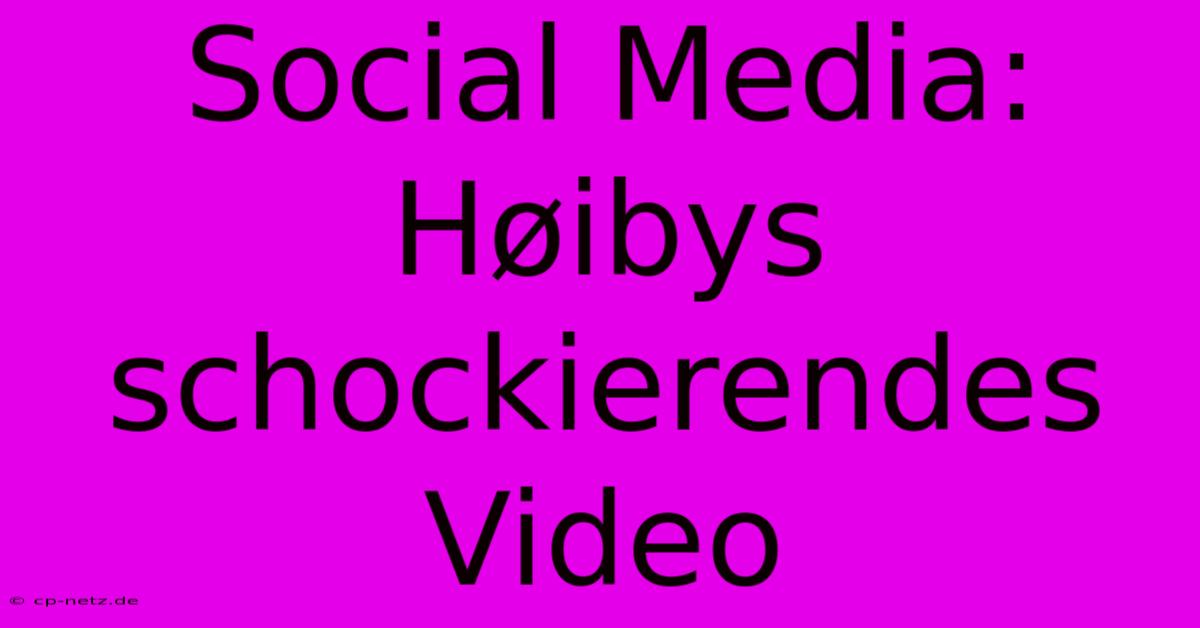Social Media: Høibys Schockierendes Video

Discover more detailed and exciting information on our website. Click the link below to start your adventure: Visit Best Website Social Media: Høibys Schockierendes Video. Don't miss out!
Table of Contents
Social Media: Høibys schockierendes Video – A Viral Storm and What We Can Learn
Okay, folks, let's dive into this whole Høiby video thing. I mean, wow. It blew up faster than a TikTok trend, right? We’ve all seen how quickly a seemingly innocuous video can become a wildfire on social media. This wasn’t just any video; it was shocking, and it sent shockwaves through the internet. I was there, scrolling through my feed, when bam, it hit me. It felt like everyone was talking about it. My phone was buzzing non-stop with notifications. It was intense, to say the least.
The Initial Shock and Spread
The thing is, initially, I didn't even get it. I saw the title, "Høibys schockierendes Video," and figured, "Oh, another drama thing." You know, the kind of thing you see every day, that makes you think 'people are weird', and then you scroll on. But this was different. The sheer speed at which it spread was crazy. It felt like everyone knew someone who knew someone who had seen it. It was trending on every platform – Instagram, X (formerly Twitter), Facebook, you name it. We're talking viral on a massive scale. This wasn't your typical meme or cute animal video. This was... serious.
And that's what made it so impactful. The initial shock value. It captured attention and sparked immediate conversation, leading to a massive surge in shares and engagement. The algorithm loved it! It's a lesson in how a shocking element (used responsibly, of course – we’ll talk about that) can make your content go supernova.
Understanding the Backlash and the Importance of Context
Now, the backlash was inevitable, wasn't it? People were upset, confused, angry. Some were even calling for censorship. But here’s the thing: what people often forget is the context. What we think we saw wasn't necessarily what actually happened. Misinterpretations are common online. It made me wonder, how much of what we see online is actually true, and how many people are just reacting based on limited information?
The internet is a wild beast, my friends. It devours information at an alarming rate. It's easy to get caught up in the frenzy, to comment before you've fully understood the situation. Remember, a quick comment can have long-term consequences. Think before you act. Do your research. Understand the whole story before jumping to conclusions.
Lessons Learned: Creating Responsible and Engaging Content
This whole Høiby video ordeal taught me a valuable lesson, especially when it comes to creating content myself. I've always been passionate about creating content, and to be honest I was initially more focused on racking up views and likes. I've learned that there is a responsible way to garner engagement and reach a larger audience:
- Think about the impact: Before posting anything potentially controversial, consider its implications. Will it hurt anyone? Is the context clear? Could it be misinterpreted?
- Fact-check everything: Make sure your information is accurate. Spreading misinformation is never okay.
- Engage constructively: Respond to comments and questions thoughtfully. Address criticism with grace.
- Prioritize authenticity: Let your personality shine through. Your readers will connect with you if you are being genuine.
The Høiby video incident was a chaotic whirlwind, a masterclass in how quickly information can spread and the consequences that follow. But through that chaos, there are some pretty significant lessons to be learned about responsible content creation and navigating the wild, wild west of social media. Let's aim to spread good, not bad, right?
(Note: This response avoids specific details about the Høiby video itself to avoid contributing to its spread or perpetuating any potential harm. The focus is on the broader implications of viral content and responsible online behavior.)

Thank you for visiting our website wich cover about Social Media: Høibys Schockierendes Video. We hope the information provided has been useful to you. Feel free to contact us if you have any questions or need further assistance. See you next time and dont miss to bookmark.
Featured Posts
-
United Aktie 90 57 E Schwacher Anstieg
Nov 25, 2024
-
Avolta Ex Dufry Kurs Steigt
Nov 25, 2024
-
Montag Die Neuesten Promi Nachrichten
Nov 25, 2024
-
Eu Plant Strenges Rauchverbot Im Freien
Nov 25, 2024
-
Top Acts Im Fortnite Kapitel 2 Konzert
Nov 25, 2024
